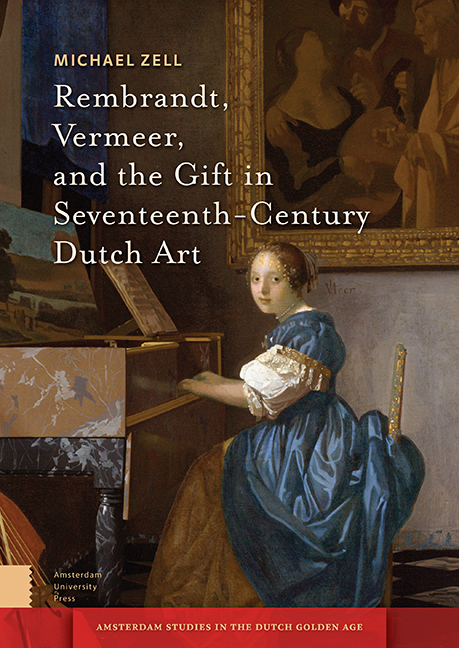Book contents
- Frontmatter
- Dedication
- Contents
- Illustrations
- Acknowledgments
- Introduction
- 1 The Gift and Art in Early Modernity
- 2 Art as Gift in the Dutch Republic
- 3 Rembrandt’s Art as Gift
- 4 Art and Leisure: Amateur Artists, Rembrandt, and Landscape Representation
- 5 For the Love of Art: Vermeer and the Poetics of the Gift
- Conclusion
- Bibliography
- Index
- Frontmatter
- Dedication
- Contents
- Illustrations
- Acknowledgments
- Introduction
- 1 The Gift and Art in Early Modernity
- 2 Art as Gift in the Dutch Republic
- 3 Rembrandt’s Art as Gift
- 4 Art and Leisure: Amateur Artists, Rembrandt, and Landscape Representation
- 5 For the Love of Art: Vermeer and the Poetics of the Gift
- Conclusion
- Bibliography
- Index
Summary
The burgher republic's vibrant gift culture interacted dynamically with its thriving commerce and trade, flourishing art scene, and competitive art market, and had a catalyzing effect on the art of the Golden Age. Dutch political, social, and cultural elites gifted artworks to initiate and perpetuate webs of reciprocity at home and abroad, and gift exchange was integrated into, not separate from, the Dutch artistic economy. Whether as strategic distributions or generous offerings, Dutch artists embraced gift exchange to cultivate professional and social relationships, while some highly self-conscious artists enlisted the cultural and social values encoded in the period's ethics of the gift in order to lay claim to social distinction, the prestige of their artworks, and to acknowledge the burgerlijk civility of the art lovers who supported them. Rembrandt adopted a particularly inventive approach grounded in the gift's capacity to nurture and reify social bonds, producing distinctive prints for circulation within gifting circuits. His many landscape drawings, which share affinities with Dutch amateur landscapes and likewise operated beyond the domain of the marketplace, also conform to the type of artwork associated by contemporaries with the alternate, social economy of gift giving. And both Rembrandt and Vermeer creatively engaged the gift system in unique works of art designed to engender viewing encounters that aestheticize the economics of artistic production and reception.
Although this book has traced the interplay between gift culture and Dutch art from the late sixteenth through the seventeenth centuries, or the entirety of the Dutch Golden Age, it is significant that the most intensive and imaginative interactions date from the 1650s through the early 1670s. Recognized as the highpoint of the Golden Age, this period also marked the end of the Dutch art market’s remarkable expansion and dynamism. Following decades of unprecedented growth and resilience, the art market began to stagnate from the 1660s onward due both to a general economic decline, accelerated by the French invasion of the Republic in 1672, and to the oversupply of paintings produced by earlier generations of artists. After the 1660s, the number of Dutch painters declined precipitously. Not coincidentally, Rembrandt and Vermeer ended their careers in diminished financial and social circumstances.
However, the economic hardships of this decline were not distributed evenly across the Republic's social classes, a phenomenon that fundamentally altered the course of Dutch painting from the second half of the seventeenth and into the eighteenth century.
- Type
- Chapter
- Information
- Publisher: Amsterdam University PressPrint publication year: 2021



